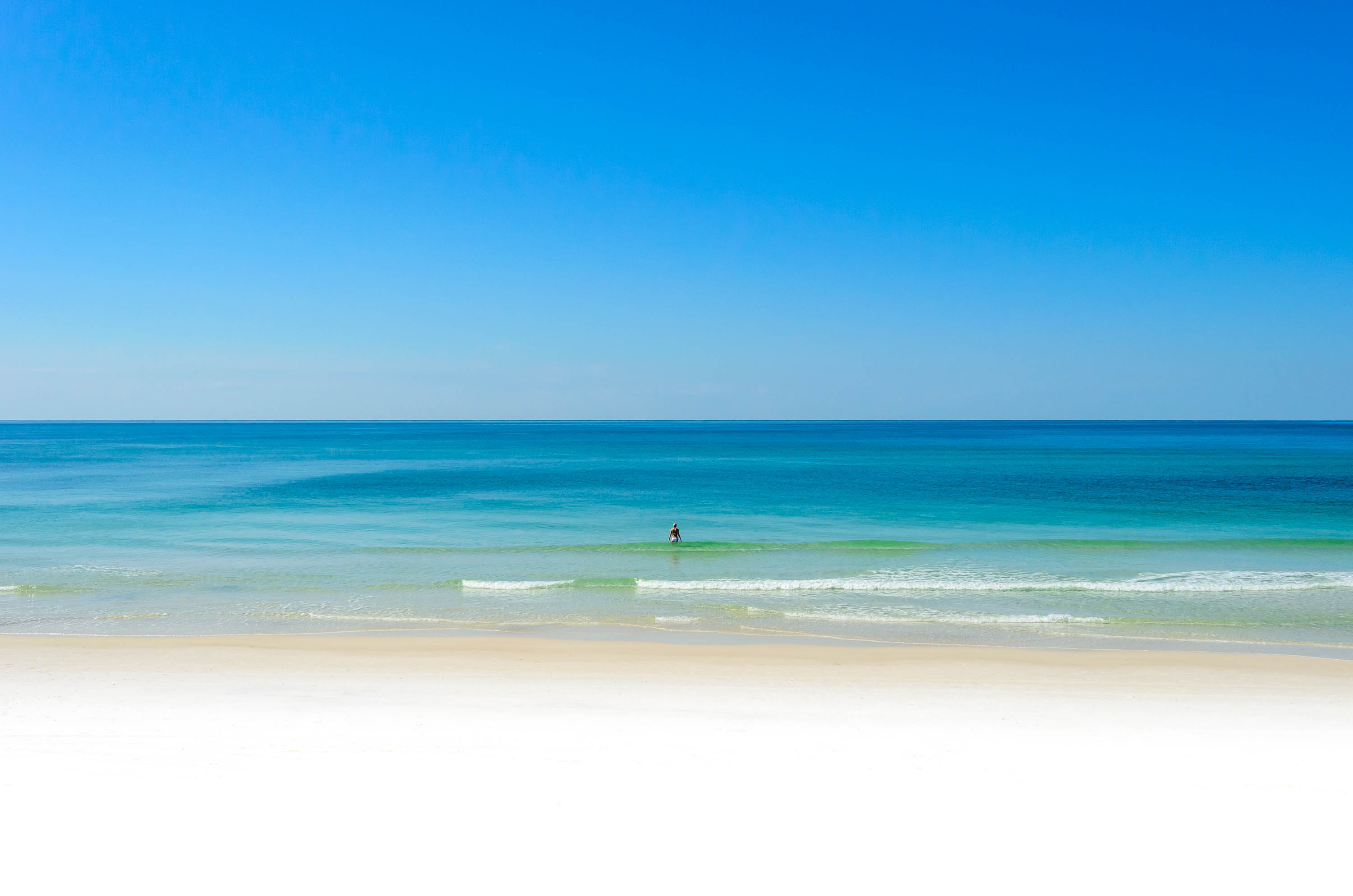By Gabriel Tynes
It?s only been 15 months since the Hildreths returned to their Blue Mountain Beach home after evacuating for Hurricane Dennis. No storm had ever breached the dunes, and since Dennis was originally forecasted to hit Alabama, the Hildreths weren?t expecting much damage. When they were allowed to return home July 11, Emmet Hildreth and his wife Linda, along with many other beachfront residents were in for a surprise.
A red tag on their front door proclaimed the structure as uninhabitable. The unprotected dune that used to be out front had become a sheer cliff, and their house was teetering on its edge. As close as two doors to their east, houses had crumbled over the cliff and onto the beach.
Not long after, in an effort to salvage nearly 300 coastal properties in similar situations, Walton County quickly issued permits for temporary seawall construction on beachfront homes. Contrary to statewide seawall construction protocol, homeowners with the temporary permits were allowed to apply for a permanent license from the Florida Department of Environmental Protection.
The Hildreths applied and were approved, and now their wall has been built. It is buried beneath more than two feet of sand sloping at the required angle and it?s covered with an organic mesh that supports 5,000 sea oats and a gaggle of other native plants. There is sand fencing at the base which is designed to encourage dune expansion.
The Hildreth?s wall meets and in some cases exceeds county and state requirements, so their application has been deemed ?complete? by the DEP. Still, they have not been granted the actual permanent permit and although their project is complete, it?s still in limbo.
Such is the quagmire that drove the Hildreths to create the Gulf Front Homeowners? Association Inc., and attend every public meeting where beach armament is in question. At some meetings, they?re allowed to speak only momentarily. At others, they?ve taken the podium for half an hour or more.
?You can talk for 30 seconds or 30 minutes,? Emmet Hildreth said. ?And people still don?t understand where you?re coming from.?
?They think it?s mainly about the beach,? Linda pointed out. ?But this is really an issue about the government wanting to get too involved in private property rights.?
After being primarily shut out of a debate regarding seawall encroachment at the Board of County Commissioners meeting Oct. 10, the Hildreths returned to the public arena two days later to fi ght a planning commission ordinance that suggested a change in the land development code.
For the record, the Hildreths seawall is not one of the nearly two dozen that was ?unknowingly? constructed on county property. For the record, the Hildreths admit they had never considered installing a wall before Dennis, but they believe it was the only way to save their home. The Hildreths prefer to call seawalls ?upland retaining walls,? a term they believe more appropriately describes the wall?s true function.
?We don?t often get the chance to tell our side of story,? Linda said, ?so people only hear the negative. They say walls will destroy the beach.
?But why do you think we live here?? She asked. ?Why do you think we bought this expensive property and pay these exorbitant taxes? It?s not because we want to destroy the beach.?
At the planning commission meeting Oct. 12, their argument was partially heard. This time, they may have made an impact.
The final item on the planning commission?s regular agenda was an amendment to the Walton County Land Development Code that would have mandated seawalls to be covered with at least 3 feet of sand and a more gradual slope. Furthermore, it included vague language that essentially would have required a second letter of county approval to be sent to the DEP, even if the applications were already ?complete? and waiting permanent status.
Emmet Hildreth disputed the amendment on three grounds and forced the planning commission to table the discussion until more information could be disseminated. Hildreth told the commission they lacked the right to force such regulations on private property.
?If you told everyone in DeFuniak Springs to plant roses in their yard would you expect them to do it?? he asked.
He admonished the commission?s attempted action as ?ex-posto facto,? and questioned the county?s legal authority to interject in DEP business.
?This county commission has said time and time again that it has no authority over construction in the Coastal Control Line,? Hildreth said, referring to an area under particular state scrutiny between the Gulf and upland structures. ?Still, here we are, making a proposal about what the county can do to trivialize the process. Our applications are complete and nowhere in the process were we ever told about a ?second letter? until tonight.?
Under pressure from county attorney David Hallman, the planning commission admitted the purpose of the amendment was to require a second letter, but planning commission director Pat Blackshear said it was actually a DEP condition and therefore a second letter ?may not be required.?
Later, Hallman said he ?wasn?t sure what the planning department was trying to do? with the amendment.
?I think there was a lot of confusion,? Hallman said of the issue, ?and ultimately because of that, the amendment was not approved.?
Hallman said he didn?t like to speculate on actions the BCC would have taken if the amendment had reached their agenda, ?but I think it is very clear we don?t have jurisdiction over the CCL,? he said.
Oddly, the amendment seemed to actually be a condition of the Florida Fish and Wildlife Commission, which according to the Hildreths has repeatedly attempted to delay beachfront property protection in order to preserve the habitats of endangered species.
Meanwhile, Emmet Hildreth pointed out that in spite of the current conditions, 20 sea turtles nested in Walton County this year, including four on Blue Mountain Beach. The total number is one nest more than last year, before the seawalls were even in place.
Such facts lead the Hildreths to ignore the testimony of the FWC. Emmet said he is also offended by the constant scrutiny of the South Walton Community Council, which he believes is the driving force behind numerous permitting delays.
But SWCC President Anita Page said her organization is simply a tool to provide citizens with information about local interests and issues, and has ?no affiliation with the FWS or DEP.?
?If Mr. Hildreth?s wall is within state guidelines and indeed is on his own property, we have no objections to it at all,? Page said.
Still, the Hildreths prefer the professional expertise of coastal engineers or marine scientists.
Brad Pickel, the Director of Beach Management for the Walton County Tourist Development Council, said that while seawall impacts tend to be site-specifi c, he doesn?t expect any immediate, dramatic changes in their effects on Walton County beaches.
?The true impact of a seawall is directly related to the time that is spent in contact with water,? Pickel said. ?As long as they?recovered, it?s not going to disturb the beach or the dunes.?
Pickel said seawall infrastructure similar to the Hildreths? can actually assist in natural dune and beach development.
?Just because the sand was trucked in on top of these walls doesn?t mean the beach or the dunes will act or react any differently,? Pickel said. ?Our beaches don?t erode every year, and outside of storm systems they actually grow. Covered seawalls aren?t going to change that.?
Linda Hildreth said that although she would like to think better of her neighbors, she believes sometimes the issue is driven by simple jealousy.
?The people who are fighting against our walls are often the people who live right across the street,? Linda said. ?You have to wonder whose side they would be on if they were in the same situation.?
It?s only been 15 months since the Hildreths returned to their Blue Mountain Beach home after evacuating for Hurricane Dennis. No storm had ever breached the dunes, and since Dennis was originally forecasted to hit Alabama, the Hildreths weren?t expecting much damage. When they were allowed to return home July 11, Emmet Hildreth and his wife Linda, along with many other beachfront residents were in for a surprise.
A red tag on their front door proclaimed the structure as uninhabitable. The unprotected dune that used to be out front had become a sheer cliff, and their house was teetering on its edge. As close as two doors to their east, houses had crumbled over the cliff and onto the beach.
Not long after, in an effort to salvage nearly 300 coastal properties in similar situations, Walton County quickly issued permits for temporary seawall construction on beachfront homes. Contrary to statewide seawall construction protocol, homeowners with the temporary permits were allowed to apply for a permanent license from the Florida Department of Environmental Protection.
The Hildreths applied and were approved, and now their wall has been built. It is buried beneath more than two feet of sand sloping at the required angle and it?s covered with an organic mesh that supports 5,000 sea oats and a gaggle of other native plants. There is sand fencing at the base which is designed to encourage dune expansion.
The Hildreth?s wall meets and in some cases exceeds county and state requirements, so their application has been deemed ?complete? by the DEP. Still, they have not been granted the actual permanent permit and although their project is complete, it?s still in limbo.
Such is the quagmire that drove the Hildreths to create the Gulf Front Homeowners? Association Inc., and attend every public meeting where beach armament is in question. At some meetings, they?re allowed to speak only momentarily. At others, they?ve taken the podium for half an hour or more.
?You can talk for 30 seconds or 30 minutes,? Emmet Hildreth said. ?And people still don?t understand where you?re coming from.?
?They think it?s mainly about the beach,? Linda pointed out. ?But this is really an issue about the government wanting to get too involved in private property rights.?
After being primarily shut out of a debate regarding seawall encroachment at the Board of County Commissioners meeting Oct. 10, the Hildreths returned to the public arena two days later to fi ght a planning commission ordinance that suggested a change in the land development code.
For the record, the Hildreths seawall is not one of the nearly two dozen that was ?unknowingly? constructed on county property. For the record, the Hildreths admit they had never considered installing a wall before Dennis, but they believe it was the only way to save their home. The Hildreths prefer to call seawalls ?upland retaining walls,? a term they believe more appropriately describes the wall?s true function.
?We don?t often get the chance to tell our side of story,? Linda said, ?so people only hear the negative. They say walls will destroy the beach.
?But why do you think we live here?? She asked. ?Why do you think we bought this expensive property and pay these exorbitant taxes? It?s not because we want to destroy the beach.?
At the planning commission meeting Oct. 12, their argument was partially heard. This time, they may have made an impact.
The final item on the planning commission?s regular agenda was an amendment to the Walton County Land Development Code that would have mandated seawalls to be covered with at least 3 feet of sand and a more gradual slope. Furthermore, it included vague language that essentially would have required a second letter of county approval to be sent to the DEP, even if the applications were already ?complete? and waiting permanent status.
Emmet Hildreth disputed the amendment on three grounds and forced the planning commission to table the discussion until more information could be disseminated. Hildreth told the commission they lacked the right to force such regulations on private property.
?If you told everyone in DeFuniak Springs to plant roses in their yard would you expect them to do it?? he asked.
He admonished the commission?s attempted action as ?ex-posto facto,? and questioned the county?s legal authority to interject in DEP business.
?This county commission has said time and time again that it has no authority over construction in the Coastal Control Line,? Hildreth said, referring to an area under particular state scrutiny between the Gulf and upland structures. ?Still, here we are, making a proposal about what the county can do to trivialize the process. Our applications are complete and nowhere in the process were we ever told about a ?second letter? until tonight.?
Under pressure from county attorney David Hallman, the planning commission admitted the purpose of the amendment was to require a second letter, but planning commission director Pat Blackshear said it was actually a DEP condition and therefore a second letter ?may not be required.?
Later, Hallman said he ?wasn?t sure what the planning department was trying to do? with the amendment.
?I think there was a lot of confusion,? Hallman said of the issue, ?and ultimately because of that, the amendment was not approved.?
Hallman said he didn?t like to speculate on actions the BCC would have taken if the amendment had reached their agenda, ?but I think it is very clear we don?t have jurisdiction over the CCL,? he said.
Oddly, the amendment seemed to actually be a condition of the Florida Fish and Wildlife Commission, which according to the Hildreths has repeatedly attempted to delay beachfront property protection in order to preserve the habitats of endangered species.
Meanwhile, Emmet Hildreth pointed out that in spite of the current conditions, 20 sea turtles nested in Walton County this year, including four on Blue Mountain Beach. The total number is one nest more than last year, before the seawalls were even in place.
Such facts lead the Hildreths to ignore the testimony of the FWC. Emmet said he is also offended by the constant scrutiny of the South Walton Community Council, which he believes is the driving force behind numerous permitting delays.
But SWCC President Anita Page said her organization is simply a tool to provide citizens with information about local interests and issues, and has ?no affiliation with the FWS or DEP.?
?If Mr. Hildreth?s wall is within state guidelines and indeed is on his own property, we have no objections to it at all,? Page said.
Still, the Hildreths prefer the professional expertise of coastal engineers or marine scientists.
Brad Pickel, the Director of Beach Management for the Walton County Tourist Development Council, said that while seawall impacts tend to be site-specifi c, he doesn?t expect any immediate, dramatic changes in their effects on Walton County beaches.
?The true impact of a seawall is directly related to the time that is spent in contact with water,? Pickel said. ?As long as they?recovered, it?s not going to disturb the beach or the dunes.?
Pickel said seawall infrastructure similar to the Hildreths? can actually assist in natural dune and beach development.
?Just because the sand was trucked in on top of these walls doesn?t mean the beach or the dunes will act or react any differently,? Pickel said. ?Our beaches don?t erode every year, and outside of storm systems they actually grow. Covered seawalls aren?t going to change that.?
Linda Hildreth said that although she would like to think better of her neighbors, she believes sometimes the issue is driven by simple jealousy.
?The people who are fighting against our walls are often the people who live right across the street,? Linda said. ?You have to wonder whose side they would be on if they were in the same situation.?

 The only road built is on my property.
The only road built is on my property.  ) In summary, there are many cases where the Gov't acts on its own behalf. I sometimes see County Attorney, Mr Hallman, cringe when a Commissioner says some things. Nothing in particular, but you can see the oh-my-god expression.
) In summary, there are many cases where the Gov't acts on its own behalf. I sometimes see County Attorney, Mr Hallman, cringe when a Commissioner says some things. Nothing in particular, but you can see the oh-my-god expression.










